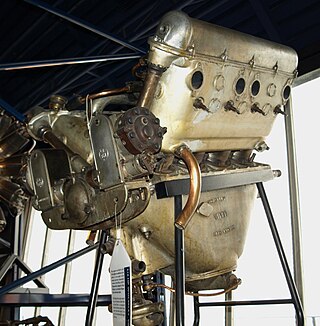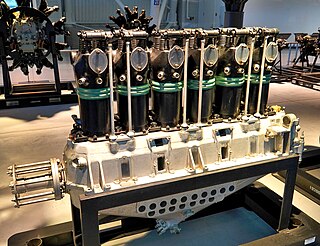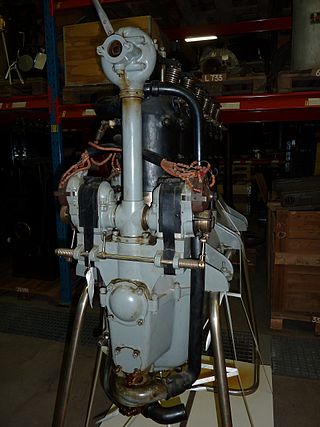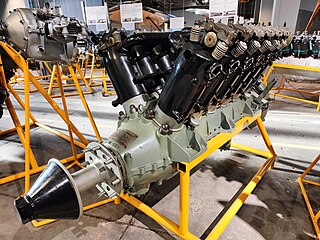
The Jumo 222 was a German high-power multiple-bank in-line piston aircraft engine from Junkers, designed under the management of Ferdinand Brandner of the Junkers Motorenwerke.

The Jumo 211 was a German inverted V-12 aircraft engine, Junkers Motoren's primary aircraft engine of World War II. It was the direct competitor to the Daimler-Benz DB 601 and closely paralleled its development. While the Daimler-Benz engine was mostly used in single-engined and twin-engined fighters, the Jumo engine was primarily used in bombers such as Junkers' own Ju 87 and Ju 88, and Heinkel's H-series examples of the Heinkel He 111 medium bomber. It was the most-produced German aero engine of the war, with almost 70,000 examples completed.

The BMW 803 was a German aircraft engine, an attempt by BMW to build a high-output aircraft engine by coupling two BMW 801 engines back-to-back, driving contra-rotating propellers. The result was a 28-cylinder, four-row radial engine, each comprising a multiple-bank in-line engine with two cylinders in each bank, which, due to cooling concerns, were liquid cooled.

The Jumo 210 was Junkers' first production inverted V12 gasoline aircraft engine, first produced in the early 1930s. Depending on the version it produced between 610 and 730 PS and can be considered a counterpart of the Rolls-Royce Kestrel in many ways. Although originally intended to be used in almost all pre-war designs, rapid progress in aircraft design quickly relegated it to the small end of the power scale by the late 1930s. Almost all aircraft designs switched to the much larger Daimler-Benz DB 600, so the 210 was produced only for a short time before Junkers responded with a larger engine of their own, the Junkers Jumo 211.

The Mercedes D.III, or F1466 as it was known internally, was a six-cylinder SOHC valvetrain liquid-cooled inline aircraft engine built by Daimler and used on a wide variety of German aircraft during World War I. The initial versions were introduced in 1914 at 120 kW (160 hp), but a series of changes improved this to 130 kW (170 hp) in 1917, and 130 kW (180 hp) by mid-1918. These later models were used on almost all late-war German fighters, and its only real competition, the BMW III, was available only in very limited numbers. Compared to the Allied engines it faced, the D.III was generally outdated.

The Wolseley Viper is a British-built, high-compression derivative of the Hispano Suiza HS-8 liquid-cooled V-8 engine, built under licence by Wolseley Motors during World War I.

The Benz Bz.IV was a German six-cylinder, water-cooled, inline engine developed for aircraft use. Deliveries began in 1916, and some 6,400 were produced.

The Mercedes D.IVa was a German six-cylinder, water-cooled, inline engine developed in 1917 for use in aircraft and built by Daimler Motoren Gesellschaft (DMG).

The BMW IV was a six-cylinder, water-cooled inline aircraft engine built in Germany in the 1920s. Power was in the 180 kW (250 hp) range.

The BMW VI was a water-cooled V-12 aircraft engine built in Germany in the 1920s. It was one of the most important German aero engines in the years leading up to World War II, with thousands built. It was further developed as the BMW VII and BMW IX, although these saw considerably less use. It was also produced in the Soviet Union as the M-17 and Japan as the Kawasaki Ha-9.

The Klimov M-103 is a V12 liquid-cooled piston aircraft engine used by Soviet aircraft during World War II.

BMW IIIa was an inline six-cylinder SOHC valvetrain, water-cooled aircraft engine, the first-ever engine produced by Bayerische Motoren Werke AG, who, at the time, were exclusively an aircraft engine manufacturer. Its success laid the foundation for future BMW engine designs. It is best known as the powerplant of the Fokker D.VIIF, which outperformed any allied aircraft.

The Argus As II was a six-cylinder, in-line, water-cooled, aircraft engine produced in Germany by Argus Motoren in 1914. The Argus As II produced 120 hp (89 kW) at 1,350 rpm.

The Junkers L2 was Junkers' first water-cooled four-stroke engine and the first to be built on a production line, though only 58 were made. It was a six-cylinder inline engine and powered many Junkers aircraft until replaced by the more powerful L5.

The Junkers L55 was Junkers' first V-12 engine, appearing in 1927 and based on a pair of six-cylinder L5s. In 1928 a supercharger was added. It was used in one or two Junkers aircraft in their early development but was replaced by the geared L88 geared V-12 of 1929.
The Junkers L88 was Junkers' first geared V-12 engine, appearing c.1930 and based on a pair of 6-cylinder L8s. In 1932 a supercharger was added. It was used in the world's second working pressurised aircraft, the Junkers Ju 49 and, for a while, in the large G 38 airliner and its Japanese built military version.

The Fiat A.22 was an Italian water-cooled aircraft engine from the 1920s. It produced 425 kW (570 hp) and powered several absolute world distance records as well as commercial passenger flights.

The Fiat A.25 was an Italian water-cooled aircraft engine from the 1920s. It produced 708 kW (950 hp) and was used by the Regia Aeronautica for fifteen years to power their Fiat BR.2 and BR.3 bombers.

The Potez 6D is a French six cylinder inverted inline aircraft engine put into production after World War II in normal and supercharged versions. Unsupercharged, it produced a take-off power of 179 kW (240 hp) at 2,530 rpm.
The Sergant A was a French 4-cylinder, air-cooled, upright inline piston engine with a maximum output of 7.5 kW (10 hp), designed to meet the needs of the very small and light single seat sports aircraft of the early 1920s. It was used by at least ten different types.



















